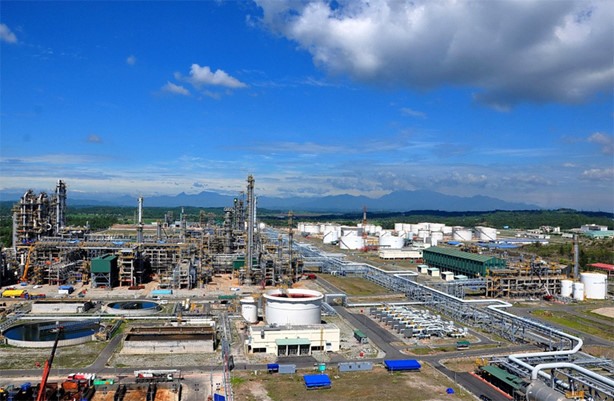Oil stocks with strong financial health good choices for investors
Oil businesses with strong financial health benefitting from the current high oil prices will be the appropriate choices for investors’ portfolio in the current volatile market context.
 |
|
A view of Nghi Sơn refinery and petrochemical complex in Thanh Hoá province. Nghi Sơn oil refinery, the largest oil project in the country, operated below capacity in the first half of this year and the delay in adjusting the costs of the base price of oil has caused many difficulties for distributors, causing a shortage of domestic supply. — VNA/VNS Photo |
HÀ NỘI Oil businesses with strong financial health benefitting from the current high oil prices will be the appropriate choices for investors’ portfolios in the current volatile market context.
The stock market ended last week with three increasing sessions and two decreasing sessions. The main movement of the VN-Index in the past week was a struggle, industry groups took turns leading and controlling the index with three prominent names of securities, banking and steel.
In the past month, many oil and gas stocks recorded an increase of more than double digits such as Nam Sông Hậu Oil and Gas Investment Company (NSH) gaining 45.5 per cent, Petrovietnam Transportation Corporation (PVT) rising 46.2 per cent, PetroVietnam Power Land (PVP) climbing 46 per cent and Bình Sơn Refinery (BSR) rising 34.2 per cent.
Positive stock price movements often reflect the sector's outlook and investor confidence in the businesses.
Mixed performances among oil and gas groups
With the ongoing tensions between Russia and Ukraine, the price of Brent crude oil was pushed to a record high since 2008 of $139.13 a barrel in March. Brent oil price cooled down gradually towards the end of 2022 but remained at the highest level in the past eight years, at over $90 per barrel.
Oil and gas enterprises are divided into three types: Upstream (including all activities of prospecting, exploration and exploitation); midstream (transportation, storage and distribution of oil and gas); downstream (converting oil and gas into finished products, delivering to customers). Therefore, the impact of an increase in oil prices on each of these groups is different.
Despite the sharp increase in oil prices in 2022, the upstream group including Vietnam Petroleum Technical Services Corporation (PVS) and PetroVietnam Drilling and Drilling Services Corporation (PVD) recorded poor business results.
PVD recorded a loss of VNĐ51 billion in the third quarter of 2022; thereby increasing the loss in nine months of 2022 to VNĐ201.66 billion. PVS in the third quarter of 2022 recorded a profit of VNĐ193 billion, down nearly 20 per cent compared to the same period last year; PVS' 9-month profit in 2022 also decreased by 21.2 per cent to VNĐ453.6 billion.
This year is considered a challenging year for the "downstream" group due to the instability of the domestic market. Nghi Sơn oil refinery, the largest oil project in the country, operated below capacity in the first half of this year and the delay in adjusting the costs of the base price of oil has caused many difficulties for distributors, causing a shortage of domestic supply. Therefore, some large distributors have to increase the source of imported goods to ensure petrol for the domestic market in the context of unfavourable developments in the world oil market and high transportation costs.
In Q3, PV Oil (OIL) lost VNĐ373.4 billion; Materials - Petroleum Joint Stock Company (COM) lost VNĐ7.7 billion; Thanh Lễ General Import-Export Trading Corporation (TLP) lost VNĐ168 billion; Nam Sông Hậu Oil and Gas Investment Company (NSH)'s profit was VNĐ762 million, down by nearly 82 per cent, Bình Sơn Refinery (BSR)'s profit was VNĐ455 billion, equivalent to a slight decrease of 3.32 per cent.
In the first nine months of 2022, no “downstream” enterprises recorded a growth in profit over the same period last year, except for BSR, which made a profit of nearly VNĐ13 trillion, nearly three times higher.
The midstream group is much more promising. Besides PetroVietnam Drilling and Well Services Corporation (PVD) with profit down 49 per cent, the rest of the companies all announced good business results, such as PetroVietnam Gas JSC (GAS) earning profit of VNĐ3.09 trillion, up 25.42 per cent; Petrovietnam Transportation Corporation (PVT) collecting VNĐ386 billion, up 152.3 per cent and PetroVietnam Power Land JSC (PVP) earning VNĐ176.3 billion, up 371.4 per cent.
VnDirect Securities Co expects the average brent oil price to reach about $90 per barrel in 2023.
For the upstream group, VnDirect expects the revised Petroleum Law passed in November will be a general legal framework for the oil industry, reducing the overlap between laws in oil and gas activities, helping to create a transparent legal framework for investors and increasing the attractiveness of the investment environment in the oil and gas sector.
As for the midstream, VnDirect sees the demand for oil and gas transportation in the domestic market will gradually increase in the next few years thanks to the operation of Bình Sơn Refinery and Nghi Sơn Refinery at full capacity. Besides, charter rates have recovered to pre-COVID-19 levels since 2022, which is a good sign for oil and gas carriers.
As for the downstream group especially large enterprises, VnDirect expects world oil prices to see more stable movements compared to 2022; Việt Nam's petrol consumption demand is forecast to reach a compound growth rate of 5.5 per cent in the 2022-2030 period, which is the basis for distribution businesses to grow in the coming years.








